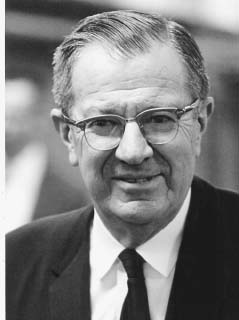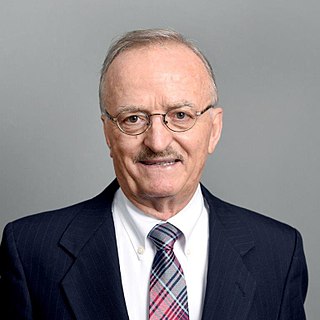Related Research Articles

A whistler is a very low frequency (VLF) electromagnetic (radio) wave generated by lightning. Frequencies of terrestrial whistlers are 1 kHz to 30 kHz, with maximum frequencies usually at 3 kHz to 5 kHz. Although they are electromagnetic waves, they occur at audio frequencies, and can be converted to audio using a suitable receiver. They are produced by lightning strikes where the impulse travels along the Earth's magnetic field lines from one hemisphere to the other. They undergo dispersion of several kHz due to the slower velocity of the lower frequencies through the plasma environments of the ionosphere and magnetosphere. Thus they are perceived as a descending tone which can last for a few seconds. The study of whistlers categorizes them into Pure Note, Diffuse, 2-Hop, and Echo Train types.

Frederick Emmons Terman was an American professor and academic administrator. He was the dean of the school of engineering from 1944 to 1958 and provost from 1955 to 1965 at Stanford University. He is widely credited as being the father of Silicon Valley.

Henry M. Gunn Senior High School is one of two public high schools in Palo Alto, California, the other being Palo Alto High School.

John Robinson Pierce, was an American engineer and author. He did extensive work concerning radio communication, microwave technology, computer music, psychoacoustics, and science fiction. Additionally to his professional career he wrote science fiction for many years using the names John Pierce, John R. Pierce, and J. J. Coupling. Born in Des Moines, Iowa, he earned his PhD from Caltech, and died in Sunnyvale, California, from complications of Parkinson's Disease.
Calvin Forrest Quate was one of the inventors of the atomic force microscope. He was a professor emeritus of Applied Physics and Electrical Engineering at Stanford University.

Constantine A. Balanis is a Greek-born American scientist, educator, author, and Regents Professor at Arizona State University. Born in Trikala, Greece on October 29, 1938. He is best known for his books in the fields of engineering electromagnetics and antenna theory. He emigrated to the United States in 1955, where he studied electrical engineering. He received United States citizenship in 1960.
In electromagnetism, the impedance of free space, Z0, is a physical constant relating the magnitudes of the electric and magnetic fields of electromagnetic radiation travelling through free space. That is, where |E| is the electric field strength, and |H| is the magnetic field strength. Its presently accepted value is

Aldo Weber Vieira da Rosa was a professor emeritus of electrical engineering at Stanford University. His research interests were in ionospheric processes, energy processes and renewable energy. He authored Fundamentals of Electronics (1989) and Fundamentals of Renewable Energy Processes (2005). His patent for the process for the production of ammonia expired in 1996.

William Littell Everitt was a noted American electrical engineer, educator, and founding member of the National Academy of Engineering. He received his Ph.D. from Ohio State University in 1933. He was adviser of numerous outstanding scientists at OSU including Karl Spangenberg, and Nelson Wax. His PhD adviser was Frederic Columbus Blake.
Robert A. Helliwell was an electrical engineer and professor at Stanford University. He was one of the pioneering scientists in the study of whistlers and related ionospheric phenomena.
The IEEE Heinrich Hertz Medal was a science award presented by the IEEE for outstanding achievements in the field of electromagnetic waves. The medal was named in honour of German physicist Heinrich Hertz, and was first proposed in 1986 by IEEE Region 8 (Germany) as a centennial recognition of Hertz's work on electromagnetic radiation theory from 1886 to 1891. The medal was first awarded in 1988, and was presented annually until 2001. It was officially discontinued in November 2009.
James R. Wait was a Canadian electrical engineer and engineering physicist. In 1977, he was elected as a member of National Academy of Engineering in Electronics, Communication & Information Systems Engineering for his contributions to electromagnetic propagation engineering as it affects communication and geophysical exploration.

Gene F. Franklin was an American electrical engineer and control theorist known for his pioneering work towards the advancement of the control systems engineering – a subfield of electrical engineering. Most of his work on control theory was adapted immediately into NASA's U.S. space program, most famously in the control systems for the Apollo missions to the Moon in 1960s–1970s.
Yahya Rahmat-Samii is the Northrop Grumman Chair Professor in Electromagnetics at the electrical engineering department at the University of California, Los Angeles, where he teaches and conducts research on microwave transmission and radio antennas. Rahmat-Samii received his Bachelor of Science degree in electrical engineering in 1970 from the University of Tehran, Iran, and the Master of Science in 1972 and the Doctor of Philosophy degrees in electrical engineering in 1975 from the University of Illinois at Urbana-Champaign. Before joining UCLA in 1989, he was a senior research scientist at the NASA Jet Propulsion Laboratory.
William Alden Edson was a scientist and engineer specializing in vacuum tube oscillators, radar, antennas and microwave technologies. His work spans universities, research institutions and commercial ventures. He taught at Illinois Institute of Technology, Georgia Institute of Technology and Stanford University.
Dr. Raymond J. Luebbers was Professor of Electrical Engineering at The Pennsylvania State University and Ohio University, a Research Scientist at the Lockheed Martin Research Laboratory in Palo Alto, CA and founder of Remcom, Inc.

Charlotte Mandell is an American literary translator. She has translated many works of poetry, fiction and philosophy from French to English, including work by Honoré de Balzac, Gustave Flaubert, Jules Verne, Guy de Maupassant, Marcel Proust, Maurice Blanchot, Antoine de Baecque, Abdelwahab Meddeb, Bernard-Henri Lévy, Jean-Luc Nancy, Mathias Énard and Jonathan Littell.
Charles Herach Papas was an American applied physicist and electrical engineer, known for his contributions to electromagnetic theory, microwaves, radiophysics, gravitational electromagnetics, astrophysics, guided waves, and remote sensing.

Weng Cho Chew is a Malaysian-American electrical engineer and applied physicist known for contributions to wave physics, especially computational electromagnetics. He is a Distinguished Professor of Electrical and Computer Engineering at Purdue University.

Douglas Henry Werner is an American scientist and engineer. He holds the John L. and Genevieve H. McCain Chair Professorship in the Penn State Department of Electrical Engineering and is the director of the Penn State University Computational Electromagnetics and Antennas Research Laboratory. Werner holds 20 patents and has over 1090 publications. He is the author/co-author of 8 books. His h-index and number of citations are recorded on his Google Scholar profile. He is internationally recognized for his expertise in electromagnetics, antenna design, optical metamaterials and metamaterial-enabled devices as well as for the development/application of inverse-design techniques.
References
- ↑ "Karl R. Spangenberg at ethw.org" . Retrieved June 23, 2021.
- ↑ "Vacuum Tubes (McGraw-Hill Electrical and Electronic Engineering Series): Karl R. Spangenberg: Amazon.com: Books" . Retrieved June 23, 2021.
- ↑ "Karl R. Spangenberg" . Retrieved June 23, 2021.
- ↑ "Electromagnetics in Space: Antenna Considerations as Related to Space Communications: Karl R. Spangenberg: Amazon.com: Books" . Retrieved June 23, 2021.
- ↑ "Karl R. Spangenberg" . Retrieved June 23, 2021.
- ↑ "Mathematics Genealogy Project (William Littell Everitt)".
- ↑ "Founding members of the National Academy of Engineering". National Academy of Engineering . Retrieved October 21, 2012.
- ↑ "Karl R. Spangenberg" . Retrieved June 23, 2021.
- ↑ "Mathematics Genealogy Project (Karl Spangenberg)".
- ↑ "Karl R. Spangenberg" . Retrieved June 23, 2021.
- ↑ "Karl R. Spangenberg" . Retrieved June 23, 2021.
- ↑ "Karl R. Spangenberg" . Retrieved June 23, 2021.
- ↑ "Palo Alto Online - Lasting Memories - Ruth Spangenberg's memorial" . Retrieved June 23, 2021.